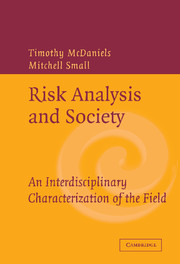Book contents
- Frontmatter
- Contents
- Contributors
- 1 Introduction – Risk Anaysis and Society: An Interdisciplinary Characterization of the Field
- PART ONE FUNDAMENTAL CHARACTER OF RISK
- 2 The Conception of Variability in Risk Analyses: Developments Since 1980
- 3 Mechanistic Considerations in the Harmonization of Dose-Response Methodology: The Role of Redundancy at Different Levels of Biological Organization
- 4 Risk of Extreme and Rare Events: Lessons from a Selection of Approaches
- 5 Environmental Risk and Justice
- PART TWO METHODS FOR RISK ASSESSMENT
- PART THREE NEW APPROACHES AND NEEDS FOR RISK MANAGEMENT
- SUMMARY AND FUTURE DIRECTIONS
- Index
- References
2 - The Conception of Variability in Risk Analyses: Developments Since 1980
Published online by Cambridge University Press: 05 June 2012
- Frontmatter
- Contents
- Contributors
- 1 Introduction – Risk Anaysis and Society: An Interdisciplinary Characterization of the Field
- PART ONE FUNDAMENTAL CHARACTER OF RISK
- 2 The Conception of Variability in Risk Analyses: Developments Since 1980
- 3 Mechanistic Considerations in the Harmonization of Dose-Response Methodology: The Role of Redundancy at Different Levels of Biological Organization
- 4 Risk of Extreme and Rare Events: Lessons from a Selection of Approaches
- 5 Environmental Risk and Justice
- PART TWO METHODS FOR RISK ASSESSMENT
- PART THREE NEW APPROACHES AND NEEDS FOR RISK MANAGEMENT
- SUMMARY AND FUTURE DIRECTIONS
- Index
- References
Summary
INTRODUCTION
This chapter offers a philosophical and historical perspective on the development of the concept of “variability” in the last few decades. The goal is not to provide a treatment of modern mathematical techniques for the analysis of data indicating variability. The recent literature contains excellent works that document analytical tools and are eminently usable by risk analysis practitioners (Cullen and Frey, 1999; Thompson, 1999). Rather, the object is to reflect on the significance and prospects for quantitative assessment of “variability” as an intellectual innovation that has emerged in part from the interdisciplinary fusion of ideas, techniques, and social needs for information for decision making that is the discipline of risk analysis.
Briefly, the nub of the innovation is distinguishing real variation among things from measurement errors, other sources of uncertainties, and stochastic fluctuations (such as the numbers of cosmic rays arriving at a detector in a specified interval). Where uncertainties reflect the imperfections in available information about the world (and are often seen as an annoying fog that obscures investigators' ability to demonstrate differences among groups, but with no real consequence or interest in itself; Hattis, 1996), real quantitative variation among things/people has real implications for differential behavior among the “things” being studied. Such differences can, for example, take the forms of (a) the relative risks to those things/people and (b) the relative desirability of devoting resources to some things rather than to others (if, for example, the things are categories such as industries that could be the subjects of safety inspections or other resource-consuming activities) (Hattis and Goble, 1994).
- Type
- Chapter
- Information
- Risk Analysis and SocietyAn Interdisciplinary Characterization of the Field, pp. 15 - 45Publisher: Cambridge University PressPrint publication year: 2003
References
- 6
- Cited by



